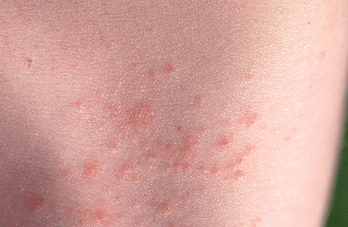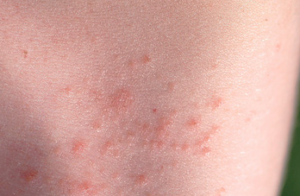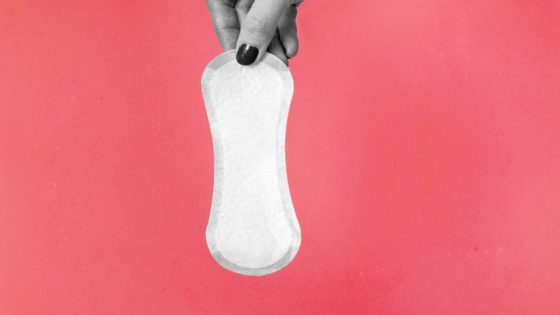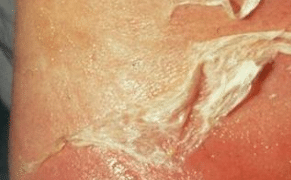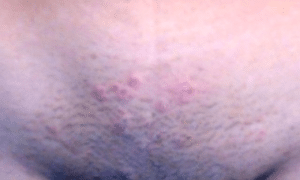What could be the cause of a rash on breast? Could it be cancer? Get overviews of rash on breast including various ways on how to get rid of it.
Rash on Breast Causes
There are many factors that cause a rash on the breast. To summarize, they fall into four categories: infections, allergies, autoimmune disorders and cancer.
- INFECTIONS
Most of the infections are due to fungal, bacterial and yeast infections.
Candidiasis
Candidiasis is caused by yeasts or fungi. Fungi are microscopic, single-cell organisms that are in the soil, air, water, animals and people. Candida yeasts thrive in moist, warm environments under on breast. They cause a rash that develops uncomfortable blisters and small cracks. Candidiasis being a fungal infection can be very itchy sometimes but however, they are often seen in people with illness that affect immune system and in people who are on antibiotic prescriptions.
Treatment: if you have been diagnosed with candidiasis your doctor may prescribe oral antifungal medications or topical antifungal creams.
Ringworm
Ringworm as the name suggest doesn’t mean that they are caused by worms. Ringworm is a type of fungal infection that is caused by a parasite that feed on dead keratin (protein that is part of the skin), nails and hair. Ringworm is round in shape, with red patches on the skin and with a very distinct ring. Ringworm is highly contagious and spreads from one person to another via shared showers, shared sheets and towels. You can also get infected by ringworm from your pets.
Treatment: Prescription of over-the-counter medications or topical antifungal creams is very effective in treating ringworm.
Mastitis
Mastitis is a very common breast infection that affects breastfeeding mums. It can also can affect women who are not breastfeeding. If untreated, mastitis causes small cracks on breast that further result to formation of painful, pus-filled abscesses in your breast or in some cases result to a big rash on breast.
Treatment: To treat mastitis antibiotics are normally prescribed to treat the infection. In case you are breastfeeding, feed your baby more frequently and empty the affected breast fully. Also warm compress can be applied to the rash on the breast to relieve the discomfort.
Mammary duct ectasia
Mammary duct ectasia occurs when a milk duct beneath your nipple widens, the duct fills with fluid. The milk duct may become blocked or clogged with a thick, sticky substance. The condition often causes no symptoms but some women have nipple discharge, a rash on the breast, breast tenderness or inflammation of the clogged duct.
Mammary duct ectasia often occurs in women of Perimenopausal age around 45 to 50 years- but it can happen after menopause too.
Treatment: the condition sometimes improves without treatment. If symptoms persist, you may need antibiotics or possibly surgery to remove the affected milk duct
- ALLERGIES
Hives
Is an example of allergic responses that result to a rash on breast is Hives. In most cases the allergens that cause allergic reaction include: plants, pollen, dust, insect stings, medication and foods.
Hives are itchy skin-colored bumps usually red in color. They can occur on any part of your body. If you press on hives, they will blanch, turning white.
Treatment: Hives are usually treated with administration of antihistamines, which block histamine (chemical that cause hives). Also topical creams such as cortisone or calamine lotion and cold compresses can be used to get rid of the hives. If you regularly suffer from hive allergies, your doctor may recommend you for a second medical opinion from an allergist.
- AUTOIMMUNE DISORDERS
There are different autoimmune disorders that can cause a rash on breast and they include:
Eczema
Eczema is also known as atopic dermatitis. It is usually associated with symptoms such as patches of inflamed red or reddish-gray skin that itchy severely. Eczema affects mostly the face, hands, feet, behind the knees and inner surface of the elbow.
Treatment: There is no known cure for eczema but its symptoms can be controlled by keeping your skin moist with fragrance-free moisturizers or by use of cortisone creams and gels. Also you need to take preventative measures such as avoiding harsh soaps and detergents.
Inverse Psoriasis
This is an autoimmune system chronic skin disorder that result to red, itchy patches and scaly skin in the fold of the body. This condition commonly affects breast, the armpits and the groin area. Inverse psoriasis usually does not have skin flare-ups that usually accompany other types of psoriasis.
Treatment: Skin medications that boost the immune system are administered to get rid of the inverse psoriasis. Also steroid creams and gels are used in many cases as the first option for treatment of inverse psoriasis.
Hyperhidrosis
This is a condition in which your body’s sweat glands produce excess sweat than is needed to cool the body. The real cause of hyperhidrosis is unknown but however, a few researches have pointed out that hyperhidrosis tend to run in families. This excess sweats act as a conducive environment for bacteria and fungi that cause rashes on the body.
Treatment: Body antiperspirants may be used on the breast. There are many body antiperspirants available either in liquid or powdered form.
In case body antiperspirants are not working you need to visit your doctor for further direction. Your doctor may either recommend you for a more powerful antiperspirant or recommend botox injections. He may also decide to go for laser or tradition surgery for removal of the sweat glands.
Hailey-Hailey Disease
Hailey-Hailey disease is associated with symptoms such as persistent blistering rash that may be found on the breast, neck, between the buttocks, armpit and the groin. This condition is an inherited disorder that comes and goes spontaneously. Some of the symptoms of Hailey-Hailey such as touch and dry skin with painful cracks may develop over a certain period of time.
Treatment: The treatment of Hailey-Hailey may involve use of over-the-counter corticosteroid creams and ointments or use of antibiotics. In case the corticosteroid creams and antibiotics fail to get rid of Hailey-Hailey you need to see your doctor for further directions. Your doctor after examination may recommend more powerful oral corticosteroids and antibiotics. He may also recommend you for a photodynamic light therapy, or laser therapy.
It is also advisable that if you have Hailey-Hailey disease, you should avoid situations that make you sweat, such as not wearing heavy clothing that doesn’t breathe and not exerting yourself too much in hot weather.
- CANCER
Breast cancer is a very common form of cancer and symptoms include:
- Pimple-like rash
- An inverted nipple that points inward rather than outward
- Pitted skin that looks like an orange peel
- Pink or red breast skin discoloration
This type of cancer is very common now days, however it is important to see your doctor promptly if you have any of the above symptoms.
Treatment: The standard treatment for breast cancer may involve surgery, radiation therapy or chemotherapy.
- OTHER CAUSES
Other possible causes that can result to a rash on your breast include:
- Heat rash or miliaria
- Hormonal changes
- Medications
- Paget’s disease of the breast
- Nipple dermatitis
- Scabies
- Shingles
- Cellulitis
Itchy Rash on Breast
Skin inflammation or dermatitis is the leading cause of breast itchiness. Different types of dermatitis can affect the breast skin, all of which cause a red, itchy rash. The skin might appear dry and flaky or have small, wet blisters.
Atopic dermatitis, commonly known as hereditary eczema, sometimes involves the breast with the nipple and areola most frequently involved. As other skin areas are typically also involved, this diagnosis usually proves straightforward.
Allergic and irritant contact dermatitis can also involve the breast, causing an itchy red rash. With these conditions, direct contact with an aggravating chemical provokes the rash. Substances that might lead to breast contact dermatitis include:
- Metals in nipple rings and jewelry especially nickel.
- Fragrance and chemicals in creams applied to the breast, such as lanolin.
- Laundry detergents, fabric conditioner, bleach or soap residue.
- Elastic materials and bands in bras and other garments.
Breast dermatitis treatment typically involves use of moisturizers and elimination of contact with any provoking chemicals. Short-term use of hydrocortisone cream might also be recommended.
Itchy rash on breast is also caused by a condition called intertrigo. Intertrigo is a superficial skin inflammation caused by a combination of moisture and friction. This condition often affects the skin folds on the underside of the breast. Itchiness along with burning or stinging develops along with red rash. Bacteria or yeast sometimes secondarily infect the area due to superficial skin breakdown.
Treatment of intertrigo involves keeping the area clean and dry along with use of protective skin ointments and drying agents, such as talcum powder. Topical antifungal or antibiotic are added if the area is seriously infected.
Heat Rash on Breast
Heat rash is also known as miliaria or prickly heat. It is a mild inflammation of clogged sweat ducts. When the sweat ducts are blocked the sweat cannot come to the surface to evaporate and becomes trapped under the skin. The rash is characterized by small, raised bumps like (coarse sandpaper) spread evenly across small patches of skin.
The rash usually goes away on its own and resolves in hours to a few days. The most common body parts affected by heat rash are areas commonly exposed to the sun such as the hands, face, and neck and elbow folds.
Heat rash may also affect areas covered by tight clothing such as the abdominal wall, groin, thigh creases, buttocks and the area under the breasts. There are four types of heat rash which are named by the way they look on the skin and they include:
- Clear (miliaria crystalia)
- Red (miliaria rubra)
- White/yellow (miliaria pustulosa)
- Deep (miliaria profunda)
Rash on Breast Cancer
Rash on breast can be a form of cancer known as inflammatory breast cancer which is a rare and aggressive cancer. It can grow and spread quickly. Its symptoms often appear like a rash or skin irritation and may include:
- Redness of breast skin
- Pain, tenderness or itching of the breast
- Nipple changes, such as dimpling, flattening or inversion.
- Feeling of warmth in one breast
- Thickening of the breast skin
- Swelling of the breast
There is also another cancerous condition called Paget’s disease of the breast (PDB) typically develops in the skin of one of the nipple and spreads to the areola and possibly the surrounding skin. The affected skin exhibits a dermatitis-like rash with accompanying itchiness.
While Paget’s disease of the breast (PDB) represents cancer of the nipple skin, most people with the disease also have an underlying breast cancer in the same breast.
According to the National Cancer Institute, Inflammatory breast cancer account for at least 5% of all breast cancers in the United States and it usually has no noticeable symptoms until skin changes are seen and felt. Some of the treatments that can be used to deal with this form of cancer include:
- Chemotherapy to reduce the growth of cancer cells
- Surgery to remove the cancer cells
- Radiation therapy
- Home therapy containing cancer hormone receptors
How to Get Rid of Rash on Breast
To get rid of rash on breast, you can try simple natural remedies or in cases of infection you need to consult your doctor. There are over 30 home remedies that can be used and to get effective relief from this problem and they include:
Apple Cider Vinegar
A chemical residue present on your clothes can cause a breast rash. Vinegar can help solve this problem.
- Mix one-half cup of white vinegar in half bucket of hot water.
- Use this solution to wash your bras and dry them in direct sunlight.
- Another option is to apply apple cider vinegar on the irritated skin. Wash the infected area with mild soapy water, rinse with cold water and pat dry. Mix one teaspoon of apple cider vinegar in a cup of water and apply it to the affected area. Do this two to three times daily. If it causes discomfort, stop using it.
Cornstarch
Cornstarch is very effective in getting rid of the itching and burning sensation that usually accompanies a breast rash. It also helps to keep the skin dry; this in turn speeds up healing process.
To use cornstarch:
- Clean thoroughly the affected area with soap and water and then pat dry with a towel.
- When the area is completely dry, dust cornstarch lightly over it
- Repeat this at least 2 times daily until you get rid of the breast rash.
Calamine Lotion
When Calamine lotion is used on a breast rash, it provides a soothing effect that helps to get rid of itching and inflammation and hence speeding up the healing process. Calamine lotion also helps to reduce the chances of infection by keeping the affected area dry.
To use calamine lotion:
- Clean the affected breast with lukewarm water and a mild soap.
- Pat the area dry by use of a towel
- Use a cotton ball to apply the lotion gently on the affected breast.
- Apply this lotion 3 times a day, until the breast rash goes away.
Aloe Vera
Aloe Vera has compounds with ingredients that are antibacterial, anti-inflammatory and antifungal in nature. These properties help to sooth the itching and burning sensation caused by rashes on your breast. For effective result you can combine aloe Vera with turmeric as it has anti-septic properties.
- Extract fresh aloe Vera gel from an aloe Vera leaf plant.
- Apply it directly on the affected area.
- Alternatively, you can use aloe Vera gel mixed with a little turmeric powder. Leave it on for 20 to 30 minutes before washing it off.
- Use aloe Vera a few times daily on your skin to get rid of the rashes completely.
Tea Tree Oil
Tea tree oil has antifungal properties and hence when used topically to treat breast rash it produces effective results. Tea tree oil also helps to keep the affected area dry a factor that prevents the growth of fungus and infection.
- Mix a few drops of pure tea tree oil with 2 tablespoon of olive oil.
- Dip a cotton ball in this mixture of oil and apply it gently on the breast rash.
- Massage the area gently before so that the oil works effectively on the breast skin.
- Do this right after taking a shower and again before going to bed.
- Please note that using tea tree oil without diluting it can cause skin irritation.
Garlic
The antiseptic and antifungal properties present in garlic can be effective in getting rid of the rash on your breast.
- Soak a few garlic cloves in one-half cup of olive oil overnight.
- Then, on the next day apply this oil on the affected area and leave it on for a few hours before washing it off.
- Use this remedy three to four times a day to get rid of the rash on breast.
- Also increase your intake of raw garlic or cooked form to speed up the healing process.
Tips to avoid breast rash
- Wear clean, dry bras made of breathable fabrics like cotton. Avoid improperly fitting bras and bras made from synthetic fabric.
- Launder your bras carefully
- Check if you are allergic to cosmetic and hygiene products that you are using.
- Reduce friction that causes the rashes under breasts, apply greasy topical ointments.
- Wear light clothing, to minimize moisture or remain in a cool environment and avoid irritants.
FURTHER REFERENCES:


